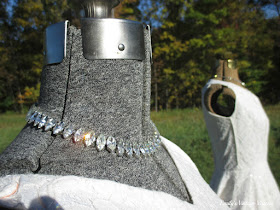I've wanted to photograph these two dresses together for a while now. I finally had the chance this fall and thankfully the weather cooperated. The dresses look much better outside against our stunning fall backdrop then they would have looked inside. Sadly all that beautiful color is gone now that we are well in to November. The gown with the long train is of course my wedding dress and the other is the one I made to wear to the reception.
This is actually the first time I've pulled these dresses out since packing them away after the wedding. Please forgive the wrinkled fabric as I didn't take the time to steam them.
You can read all about the
construction of these dresses here. But I thought this was a good time to share some more detailed shots too. :) (There are loads of
wedding photos in this post. If you're interested in how I planned my vintage themed wedding check out
this post.)
Normally you want your bias tape to match your project. I used peach bias tape to bind the neck, arms and hem of my wedding gown because that's what I had on hand at the time. Plus I really didn't care that it didn't match, I just wanted the dress done!
My felt flowers are still looking nice! The corsages were costume made by Lucy of
1940s Style for You. Lucy also runs an
Etsy shop of the same name. I made all our bouquets using wool felt, floral wire and an array of vintage mother of pearl, plastic and rhinestone buttons. I know I took photos while I was making them but can't seem to find the flash drive that hold them. Pooh! But when I do I'll post a tutorial for sure!
At some point I plan to do some major deconstruction and refitting of my reception dress. I had to resize the pattern which created some fitting issues with the bodice. It was thrown together pretty quickly the week before the wedding and never fit right. I don't like looking at the picture of me wearing it because I can see how wonky it is. Anyone else have projects like that? It would make a great outfit for a fancy News Year's Eve party so it's totally worth spending some time to fix it if I can.
I plan to do the following to my reception dress:
- Detach the skirt and bodice
- Rework the bodice to remove the excess fabric/bulk from neck and bust area. I added way to much ease when I resized the pattern. This should help the neck lay a little smoother. It's also tight under the arms so I need to do something about that.
- Shorten the skirt 2 to 3 inches
- Replace the zipper with one that is less bulky.
And a few last shots of me with my creations. And a peak at how I look on a non vintage day, which I'll be honest is most days during the week. I'm really a jeans and t-shirt (or sweater if it's chilly!) kind of girl, but that's because my work day starts so early and I'm lazy in the mornings!
There, now you're totally sick of seeing wedding dress photos! :)




























